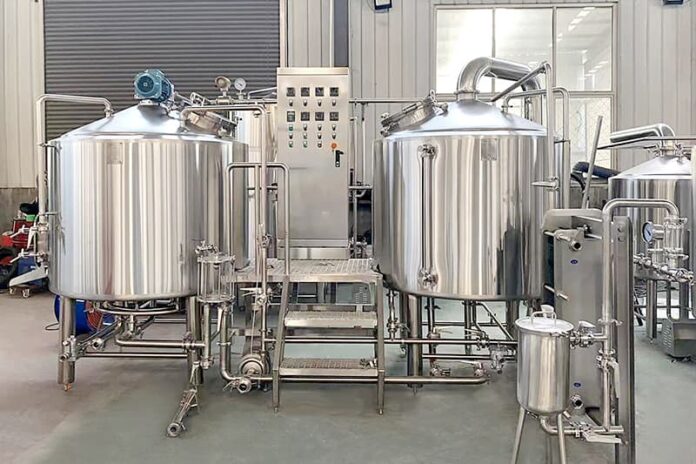BlueWeave Consulting, a leading strategic consulting and market research firm, in its recent study, estimated global brewery equipment market size at USD 19.72 billion in 2022. During the forecast period between 2023 and 2029, BlueWeave expects global brewery equipment market size to grow at a steady CAGR of 6.1% reaching a value of USD 29.68 billion by 2029. Major growth factors for global brewery equipment market include increasing customers’ preference for handcrafted beer and other alcoholic beverages, rising brewpubs and beer-producing businesses, and expanding beer culture particularly among young people. Increasing beer consumption is assisting in the global market expansion of all-in-one brewing systems. Beer is becoming increasingly popular due to perceived benefits, such as low calorie count and the presence of a substantial number of antioxidants. It drives the demand for beer brewing equipment. There could be a rise in demand for brewery equipment during the period in analysis due to customers’ preference for craft breweries due to their distinct flavors and expanding global appeal. The increasing investments, coupled with the increased domination of beer culture in many parts of the world, can also help the growth of the beer brewing equipment market. This equipment is mostly a collection of monitoring systems and instruments used in small, medium, and large-scale beer processing. The growing popularity of home brewing equipment for both commercial and non-commercial use is also expected to boost the expansion of global brewery equipment market during period in analysis.
Global Brewery Equipment Market – Overview
Brewery equipment refers to a variety of units or pieces of equipment used in brewery processing or beer-making businesses, such as brewpubs and craft breweries. The process or business of brewing beer is referred to as a brewery. End-user demand is increasing for many types of customized and automated brewery equipment, including micro and macro/industrial breweries. Brewery equipment manufacturers are developing solutions that can improve efficiency and minimize energy use. Innovations in home beer brewing machinery, microbrewery equipment, electric brewing systems, home beer brewing kits, and automated brewing systems are opening up new markets for industry participants. Companies in the brewery equipment market can benefit from digitalization and automation of equipment for process optimization. Brewery automation with advanced networking capabilities is intended to reduce the time required to manage equipment and operations while also increasing the scale of operation while ensuring consistent quality. For example, a brewing system can cut production time in half while increasing capacity by 25%.
Sample Request @ https://www.blueweaveconsulting.com/report/brewery-equipment-market/report-sample
Impact of COVID-19 on Global Brewery Equipment Market
COVID-19 had a detrimental impact on economies across the world. Evidently, it also had an indirect impact on the brewing equipment market. As strict lockdown measures were enforced differently by countries around the world, one commonality was that clubs, pubs, and restaurants were closed down everywhere because they violated the idea of social separation, which has become a requirement in these times. The employment generated by the beer-making business in Europe fell by 33% in 2020. Overall beer volume sales in the United States declined 3% in 2020, while craft brewer volume sales fell 9%, lowering small and independent brewers’ volume share of the United States beer market to 12.3%. Breweries all around the world are being affected differently depending on the size of their manufacturing activities. The closure of on-site establishments has harmed breweries because it is their primary source of revenue. To stay in business, they have had to create new distribution channels, such as home delivery and brewery applications that eliminate the need for customers to visit the brewery. However, other beer distribution mechanisms, such as mail and e-commerce platforms, have seen a significant expansion. Also, manufacturers are working on producing quality products while keeping new market trends in mind in order to meet consumer demands in the post-pandemic phase. New technical breakthroughs will help to improve the availability of brewery equipment in developing and emerging countries following the pandemic.
Global Brewery Equipment Market – By Product
By product, global brewery equipment market is divided into Fermentation Equipment, Brew House Equipment, Carbonation, Control & Monitoring, and Filling & Packaging segments. The fermentation equipment segment is expected to hold the highest market share during the forecast period because of the increased use of fermentation tanks for a longer amount of time throughout the brewing process. The wort is maintained in the fermentation tank for an extended amount of time after the brewing and mashing processes. The emission of acid increases the likelihood of tank corrosion. This is expected to increase the need for fermenters and, as a result, the fermentation tank segment throughout the forecast period. Additionally, advancement of technology in equipment and customization of equipment are expected to fuel the fermentation unit segment during the forecast period.
Competitive Landscape
Major players operating in global brewery equipment market include BASF SE,Lesaffre,Associated British Foods P.L.C.,Chr. Hansen Holding A/S,DuPont,DSM, Dyadic International Inc., Advanced Enzyme Technologies Ltd, Adisseo,Amano Enzyme Inc., Codexis Incorporated,A.B. Enzymes,Novozymes A/S,BioResource International Inc., andCargill, Incorporated. To further enhance their market share, these companies employ various strategies, including mergers and acquisitions, partnerships, joint ventures, license agreements, and new product launches.
Contact Us:
BlueWeave Research Blog
Phone No: +1 866 658 6826
Email: info@blueweaveconsulting.com














